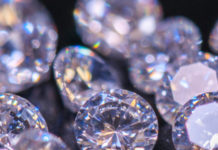
[miningmx.com] — WHEN Petra Diamonds took over ASX-listed Crown Diamonds in 2005, the main point of interest for the financial media lay in the controversial background of Crown’s founder Charles Mostert.
With the benefit of hindsight, that shouldn’t have been the case. Because six years on Petra has turned out to be the star performer in the diamond mining space.
Sadly for SA investors, Petra isn’t listed on the JSE – despite the fact nearly all its operating mines are located in South Africa. To buy London-listed Petra you need to dip into your foreign investment allowance.
Over the past two years Petra has coped with the dramatic boom and bust cycle in the diamond business far better than more highly rated and/or touted competitors that have simply failed to measure up.
Mostert was, of course, the former financial director at DRDGold who became embroiled in a massive legal fallout with then DRDGold CEO Mark Wellesley-Wood over various deals he’d done in Australia that went sour.
Crown’s assets – three small SA diamond mines – were so-so operations that had been living a hand-to-mouth existence “since the rinderpest’ and with more previous owners than a second-hand VW Beetle.
Petra was then a largely unknown diamond exploration junior run by chairman and founder Adonis Pouroulis – son of mining entrepreneur Loucas. The company’s unique selling point at that stage was its exploration prospects in Angola, for which Pouroulis held high hopes.
Frankly, there seemed to be far better diamond investment prospects around. One was Trans Hex – then SA’s second largest diamond producer – which appeared the logical “heir apparent’ in SA as De Beers started to restructure and sell off those SA operations it no longer wanted to own.
Another was the “new kid on the block’ – Clifford Elphick – who was then in the process of setting up Gem Diamonds (Gem). Elphick was a former PA to the late Harry Oppenheimer and former MD of the Oppenheimer family business, E Oppenheimer & Son.
Elphick moved into the diamond sector on his own account in 2005, to the irritation of De Beers chairperson Nicky Oppenheimer, who viewed his actions as disloyal – not least because he recruited a number of top De Beers staffers – although not long afterwards De Beers was retrenching its own executives in droves.
With his highly regarded credentials, Elphick was taken seriously by the diamond establishment. He kicked off in style, buying the Letseng diamond mine in Lesotho from JCI/Matodzi in 2006 before going for a London listing in February 2007, which raised US$600m. Elphick was described in July 2007 as “a man on a mission’ by Cadiz Corporate Solutions mining consultant Peter Major.
Little attention was paid to the management team Pouroulis was building up, which included CEO Johan Dippenaar – who formerly ran Crown – technical director Jim Davidson and finance director David Abery.
Fast forward to today. Petra has just agreed to buy its fifth diamond mine – Finsch – from De Beers for R1,4bn, which will make it one of the world’s largest diamond mining groups.
Petra’s share price has staged a powerful comeback from the meltdown that hit the diamond sector from year-end 2008 due to the global financial crisis.
VANITY AND GREED
Diamonds – it should never be forgotten – are the ultimate luxury goods. You don’t really need them and you need expert valuation skills to buy them for investment purposes. The modern diamond business has been built on the long-running and highly successful marketing campaign launched decades ago by De Beers to convince brides-to-be they must have a diamond engagement ring.
That was underpinned by the monopolistic control of the rough diamond business, enforced by the now defunct Central Selling Organisation – the CSO or “cartel’ as it was widely known.
CSO founder Sir Ernest Oppenheimer reportedly once described the diamond business as being based on “the vanity of women and the greed of men’. Those are probably sound business fundamentals and the reasons why there’s a diamond mining renaissance under way, with a string of new mines in SA, Lesotho and Botswana due to start production within the next two years.
That despite the market slaughter during 2008/2009, when plunging diamond prices and sales volumes sucked the share prices of diamond mining companies down like swimmers caught in the vortex created by a sinking ship.
Gem had listed at ₤9,50/share in February 2007 and subsequently traded as high as ₤11,40 by June that year. When the wheels came off the market, the stock plunged to 123p/share by April 2009, from where it has “recovered’ over recent months to get back to current levels of around 260p/share.
By comparison, Petra dropped from 145p in January 2008 to around 50p/share by January 2010, from where it has bounced back to new record levels around 180p/share. This recovery has been based on the acquisition of various mines from De Beers, which have boosted Petra’s annual production from fewer than 200 000 carats in 2006 to a current estimated 2,8m carats, if you include Finsch.
Management expects output to reach 4m carats/year by 2014.
The mines bought include the Koffiefontein, Cullinan, Kimberley Underground and Finsch operations in SA and the Williamson mine in Tanzania.
Petra has been criticised by Roger Bade – analyst at British institution Libertas – for its overwhelming exposure to SA. However, it’s educational to look at what happened to Gem, which went on an international spending spree following its listing in 2007.
Gem invested the $600m raised in exploration ventures and operating mines spread throughout the Central African Republic, Angola, Botswana, Indonesia, Australia and the Democratic Republic of Congo (DRC). Almost all of them have been sold off or placed on care and maintenance, with the group’s only operating mine outside Lesotho being the slimmed down Ellendale complex in Australia.
In financial 2009, Gem took a $338,2m impairment charge, in addition to reporting a taxed loss of $179,3m on “discontinued operations’ as part of a total attributable loss of $552.8m. The company had to raise $107m April that year to pay off debts.
Elphick may now be looking at new ventures outside diamonds. He’s the non-executive chairman of London-listed Zanaga Iron Ore, which is developing an iron ore mine in the DRC.
But at least Gem’s share price is currently going up – albeit from rock bottom. Which is a lot more than can be said about Rockwell Diamonds and Trans Hex – both of which SA investors can buy on the JSE, although many may well have regretted doing.
WHEN THE WHEELS COME OFF
Rockwell’s main market is on the Toronto Stock Exchange, where its price collapsed from 80c in mid-2007 to around 6c/share by mid-2009, where it has remained since.
That despite claims by management in February last year Rockwell was about to resume its growth profile after raising C$17m. A year later CEO John Bristow has stepped down and Rockwell reckons it may need to raise up to another C$35m to fund proposed expansions at its Tirisano and Wouterspan mines.
Bristow – who remains a director and will consult to the company until his replacement is found – says the specific details of the capital programme are “work in progress’ and that number could well be lower.
But Rockwell’s current market cap is only around C$30m, so it looks like its existing shareholders are in for further dilution on a grand scale.
A bit of history is relevant here. Over the course of 2008/2009, Rockwell was the subject of a failed hostile takeover bid by Swiss-based Pala Investments. The eventual outcome of that bitter confrontation was the fund-raising exercise held between December 2009 and February 2010, which brought in the C$17m – far more than Rockwell management initially expected it would be able to raise.
But Pala had sold its 20% stake in the company and walked away prior to that. Pala COO Colin Murray said in July 2009: “We’re selling because we’re no longer interested in supporting this management.’
With hindsight, that looks a good call – although Rockwell chairperson David Copeland protests such an assessment. He describes Pala as “undertakers who did a lot of damage to Rockwell, from which the company is still trying to recover’.
Then there’s Trans Hex, which seemed to have turned the corner last year – only to have its wheels come off yet again. Trans Hex shares traded as high as R19,50 in 2006. Operating problems in Angola dropped them to around R11 by early 2008.
Then they plunged to as low as 100c in 2009 before staging a recovery to around 530c/share early last year, when it seemed the group was finally coming right.
Wrong! Its price is currently back around 235c/share following production problems at its core alluvial operations in the Northern Cape, which plunged the group back into a loss-making situation for the six months to end-September 2010.
This caught investors by surprise, because Trans Hex’s Achilles heel has traditionally been its Angolan operations. It went into Angola boots and all from 2001, using political contacts provided by former chairman Tokyo Sexwale. The results were disastrous, because the financial and operating conditions in Angola were heavily weighted in favour of its government.
CEO Llewellyn Delport – who inherited the situation when former CEO Calvyn Gardner abruptly quit – has spent much of the past five years trying to sort it out, which he seems to have finally achieved at its new Luana operation.
Petra took a tougher line on Angola and walked away from its previously much-vaunted Alto Cuilo kimberlite project to focus on buying producing mines in SA.
The message should be clear: Diamond mining isn’t for sissies and neither is investing in diamond shares.
Despite that, investors again seem to be piling into the sector. Their optimism is based on the favourable medium- and long-term outlooks for the sector, given supply constraints and expectations that demand will continue to rise, particularly from China.
“We believe the prospects for the global rough diamond sector remain good. Our view is that the medium-term outlook suggests an upward trend in rough diamond prices,’ declared RBC Capital Markets analyst Des Kilalea in December. Kilalea put an “outperform’ buy recommendation on Petra in September last year, when its share sat at 80p but predicting it would reach 140p.
Said Kilalea: “Petra is one of the few junior or mid-cap diamond mining companies to deliver on its potential. Its growth profile should take the company to production of over 3m carats by 2019. No other listed producer offers this.’
Kilalea isn’t alone in his assessment, which helps explain the string of new mines due to start up in Botswana, SA and Lesotho over the next two years.
James Campbell – former MD of African Diamonds, who has now moved to Lucara Diamond Corporation (Lucara) – says: “When you combine the limited amounts spent on exploring for new diamond mines with the expected falling production from a number of large mines, you’re looking at a large drop off in supply.’
In Botswana, Gem Diamonds has been awarded a mining licence for the Gope project in the central Kalahari, which it originally bought from De Beers in 2007 for $34m. Plans are to bring the mine into production during 2013, but mine plans and capex details will only be released on 15 March, when Gem presents its 2010 financial results.
Also in Botswana, TSX-listed Lucara plans to start production from its AK6 mine by year-end 2011 and ramp up to full output early next year. Lucara acquired AK6 by taking over its partner in the venture – London AIM-listed African Diamonds – whose founder and former chairman John Teeling intends heading off to try and do it all over again through his new venture, Botswana Exploration.
Lucara is to carry out a private placing to raise $60m to help fund AK6, as well as the Mothae diamond mine in Lesotho, where it’s currently doing trial mining.
At the same time AIM-listed Namakwa Diamonds is raising around $55m to pay for the continuing development of its Kao mine, also in Lesotho. Kilalea’s assessment of Namakwa’s situation highlights some of the pitfalls facing diamond producers.
He commented in a recent research report on Namakwa: “The need to raise new funds, while not unexpected, is unfortunate in our view and largely arises because the North West mines on which Namakwa was hoping to build production to some 126 000 carats a year by 2010 have not delivered. In part, that was because of the collapse of diamond prices; but it also reflected costs, which were too high and probably overly high prices for farms purchased.
“To some extent Namakwa suffered as Gem Diamonds did in the DRC: paying too much for alluvial farms and not understanding the ore bodies.’
Then there’s AIM-listed Firestone Diamonds, which last year brought the BK11 mine in Botswana into commercial production, and also plans to restart operations at the Liqhobong mine in Lesotho this year. Firestone raised ₤13m early in December at 25p/share to pay for the work at Liqhobong. The shares are currently at 33,25p.
In SA, JSE and AIM-listed Diamondcorp raised ₤2,95m early in December to pay for additional development work on its Lace kimberlite diamond mine near Kroonstad in the Free State. The shares were placed at 8,5p – a discount of 11,7% to its closing price of 9,6p on 6 December – and they currently sit at around 12,75p.
Diamondcorp CEO Paul Loudon says: “Raising this money was somewhat easier than raising the ₤7m we needed back in April. If you look at other placings – such as that by Firestone to raise ₤13m – I think there’s a greater enthusiasm from investors for diamond companies than there was 12 months ago.’
So, with apologies to Robert Matthew Van Winkle – better known as rapper Vanilla Ice of “Ice Ice Baby” fame –
“Now that the share is JUMPING with the Funds kicked on and the money is PUMPING…”
– The article first appeared in Finweek










